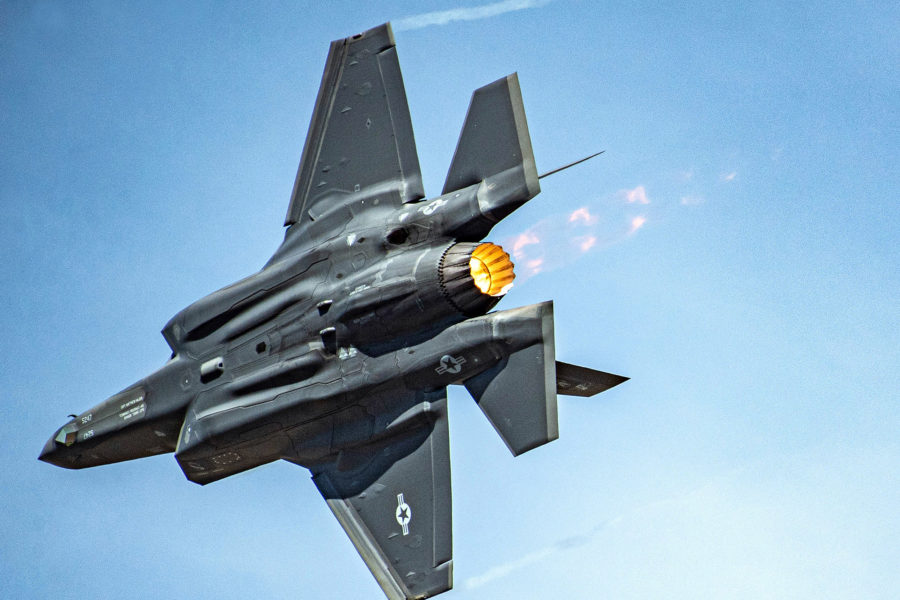Congress wants new engines in the current and future F-35 fleet, with installs starting in 2027, according to language in the conference version of the 2022 National Defense Authorization Act. It wants a joint plan for doing so from the Secretary of the Air Force and the Undersecretary of Defense for Acquisition and Sustainment within two weeks of the delivery of the fiscal 2023 budget request to Congress.
It also wants a plan on the future of propulsion for the F-35B and C-models—also to be installed starting in 2027—but left open whether the new engines for those aircraft will be AETP derivatives or Pratt & Whitney’s proposed enhanced F135.
The mandate plan, which is included in the compromise version of the fiscal 2022 defense policy bill, requires a “competitive acquisition strategy, informed by fiscal considerations” from the Air Force on how it will equip all F-35As—including those already in service—with the new AETP powerplants. Congress wants a schedule “annotating pertinent milestones and yearly fiscal resource requirements for the implementation of such a strategy.”
Lt. Gen. Eric T. Fick, the Joint Program Office director of the F-35, has said that if the Air Force is to put an AETP engine in its F-35As, it would bear the cost of development and production alone, as other users of the jet with the F-35B and C variants could not directly use such a powerplant.
General Electric and Pratt & Whitney are in the midst of testing their XA-100 and XA-101 prototypes, respectively, which were developed under the AETP. The new engines provide substantial increases in performance, with a 30 percent increase in range or 40 percent boost in persistence, made possible by a 25 percent reduction in fuel burn. Both engines would also provide double-digit improvements in acceleration.
The enhancements would extend the range of F-35s and reduce their dependence on tankers, particularly in or near contested airspace.
Both companies said they could meet Congress’ previously expressed interest in starting an AETP retrofit on the F-35 circa 2027, although officials from both companies described that timetable as ambitious.
What About Navy, Marine Corps F-35s?
The compromise National Defense Authorization Act mandates a similar report from the Secretary of the Navy, “on how it will integrate a new propulsion system in the F-35B and C models. Both GE and Pratt have said that the F-35B’s downward-rotating rear nozzle makes the AETP engines incompatible with that aircraft, due to its third-stream air bypass system. However, Fick has said that all variants of the F-35 will need an improved propulsion system to take full advantage of the F-35 Block 4 capability upgrades now in development. While the Navy could potentially use an AETP with heavy modification—either the engine or the C-model’s carrier arrestor hook would have to be reconfigured—the most likely solution would be the Enhanced Engine Package (EEP), which Pratt has proposed for its own F135 engine that now powers the whole F-35 fleet.
The NDAA says that the “advanced propulsion system” that congress wants in the F-35B and C models “means a derivative” of the AETP or “a derivative of a propulsion system previously developed for the F-35 aircraft.”
As part of the report from the Navy, Congress wants to know how much a new engine would improve the “combat effectiveness and sustainment costs” of the F-35B and C, “including any effects resulting from A) increased thrust, fuel efficiency, thermal capacity, and electrical generation, and B) improvements in acceleration, speed, range, and overall mission effectiveness.”
The Navy report is also to provide an assessment of how an advanced propulsion system could reduce aerial tanking requirements, and any “overall cost benefit” from “reduced acquisition and sustainment.”
Like the Air Force, the Navy is to provide a competitive acquisition strategy, as well as “consideration of technical limitations” of such an enterprise.
Congress did not specify whether the competitive acquisition strategies to be evaluated include a winner-take-all approach, or whether it will consider annual competitive buys, as was done during the “Great Engine War” of the 1980s. Under that approach GE and Pratt competed for the lion’s share of engine production for the F-15 and F-16 in any given year, with the “loser” receiving at least some work. The benefit was constant competition and product improvement, with the byproduct of maintaining two companies capable of fighter engine production for wartime surge capacity.
GE designed the F136 engine for the F-35, as the Pentagon planned to conduct a similar annual engine competition, but former Defense Secretary Robert Gates shut down the competition, saying it was unnecessary and wasteful.
The JPO estimates that more than 5,000 F-35s may be produced, including U.S., partner, and foreign military sales customers.
